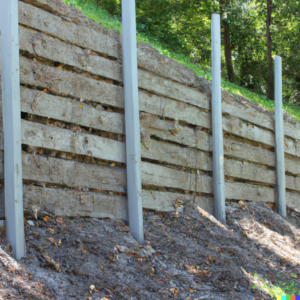The primary purpose of retaining walls is to provide structural support and prevent the erosion or collapse of soil in areas with significant grade changes or sloping terrain. Retaining walls serve several important functions: Soil retention which is the creation of a barrier that supports the weight of the soil, slope stabilization, water management, and in general structural support. Many materials have been used historically in the construction of retaining walls but for the purposes of this article we will be focusing on the usage of timber. There are many advantages of using wood in this structure, but the principles are its cost-effectiveness and it ease of installation. Wood is often more affordable compared to other materials commonly used for retaining walls, such as concrete or stone. The lightweight nature of wood makes it easier to handle, transport, and construct, potentially reducing labor and equipment costs.
There are caveats to these benefits, namely its overall degradation over time. Wood retaining walls may have an overall lifespan on the order of 10 to 20 years depending upon the quality of construction. However, the wasting nature of wind and water always limit the ceiling of this lifespan no matter how well these walls are constructed. The factors that qualitatively contribute to this wasting are as follows: The type of wood used, the quality of construction, and the nature of the environmental conditions they are exposed to. Additionally depending upon the region in which the walls are constructed over time, wood retaining walls can deteriorate due to factors like moisture, insect infestation, rot, and general wear and tear.
There are important signs to look out for when determining the lifespan of your existing retaining wall. These will indicate the need for replacing any old wood that seeks to impede the overall functionality of the structure. Firstly, if the wall is leaning, bulging, or showing signs of significant movement, it may be unsafe and require immediate replacement. Secondly, wood is susceptible to rotting when exposed to moisture and can become weak and unstable. If you notice extensive rotting, crumbling, or softening of the wood, it is time to replace the retaining wall. Thirdly, certain insects, like termites, can damage wooden structures. If you observe signs of insect infestation, such as tunnels or sawdust-like residue, it is crucial to address the issue promptly. Additionally, evidence of excessive warping or cracking may indicate age-related deterioration. As wood ages, it may warp, crack, or splinter. When these issues become severe, it can compromise the structural integrity of the retaining wall, necessitating replacement. Finally, retaining walls should have proper drainage systems to prevent water buildup and soil erosion. If your existing wall is not effectively draining water or is causing excessive water accumulation, it may need replacement or repair.
It’s important to regularly inspect your wood retaining walls for any signs of damage or deterioration. If you notice any of the above issues or have concerns about the stability of the wall, it is advisable to consult with a professional contractor or engineer who can assess the situation and provide appropriate guidance on whether replacement is necessary.

